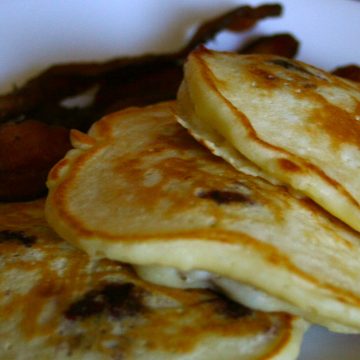It occurs to me that this week marks the third anniversary of Edible Witness! Three years of me yammering on, mostly about the weather, and probably peaches. And since I enjoy tying things together thematically, I realized that my plan to devote this week’s column to making pancakes works perfectly in tandem with my inaugural column, which was devoted to making a humble polenta-and-eggs with tomato sauce. Delicious, breakfast-for-dinner kismet! It’s all happening!
Of course, you don’t need to make these pancakes for dinner, though I wouldn’t stop you from doing it. They are, for me, more of a leisurely Saturday morning thing, because I have long since stopped using boxed pancake mix and like to make pancakes from scratch. While pancakes-from-a-box have actually become pretty good, proper buttermilk pancakes are a special weekend treat that far outshine the pre-mixed variety. They take a little more time and care, but the end result is worth it. Pair it with some bacon, coffee and a morning paper, and you won’t go back.
Everybody has a specific way they like to make and serve pancakes. I always tend to chop up some bananas or toss in blueberries (as pictured), and go light on the syrup and butter. My father likes to pair each bite of stacked pancakes with a not-unsubstantial cube of butter. The Resident Eater tends to drown his in syrup. However you like yours dressed up or down, this recipe is flexible enough to accommodate all types of pancake eaters. The key is still in the batter itself, which yields a light, moist, slightly buttery cake.
Luckily, the good people at Cook’s Illustrated nerded out hard to bring us this recipe, which I’ve found to be the best of all the different recipes and methods I’ve tried in order to yield the perfect buttermilk pancake (recipes using yeast, folding in egg whites, oven-baking pancakes — none of them did quite the trick). They discovered the use of sour cream for tanginess and moisture that wouldn’t water down the batter, combined with the right proportion of leaveners so the batter wouldn’t be gummy and heavy. The batter also contains melted butter, which provides a nice, buttery finish allowing you to avoid making them heavy with butter in the pan. I love you, America’s Test Kitchen nerds!
We have an electric griddle (which is great for making large quantities quickly, with controlled and even heat), but pancakes can be cooked in any pan. Large and non-stick works best, and be sure not to crowd your pancakes too much. I usually keep them on a tray in a 200F oven to keep them warm as I cook in batches. Throw in whatever manner of fruit you want (1 banana, chopped; a handful or two of blueberries or blackberries), or keep them unadorned and top with whatever you want at the end (icing sugar, berries, bananas and toasted coconut, or the classic butter and syrup). The rest (i.e., what or how much bacon you are serving with the pancakes) is up to you.
Buttermilk Pancakes
Adapted, slightly, from Cook’s Illustrated
Makes 16, 4-inch pancakes
- 2 cups flour
- 1 ½ tbsp sugar
- ½ tsp salt
- 1 tsp baking powder*
- ½ tsp baking soda
- 2 cups buttermilk**
- 1/4 cup sour cream or yogurt
- 2 large eggs
- 3 tbsp unsalted butter, melted and cooled slightly
- vegetable oil or cooking spray
*If you will be adding fruit (especially berries), try to use aluminum-free baking powder. It will assist in preventing the berries from changing the colour of your batter.
**If you don’t have buttermilk on hand, use milk combined with lemon juice or white vinegar (1 tbsp per cup) and let stand 10 minutes.
1. Whisk flour, sugar, salt, baking powder and baking soda together in medium bowl. In second medium bowl, whisk together buttermilk, sour cream or yogurt, eggs and melted butter.
2. Make a well in centre of dry ingredients and pour in wet ingredients; gently stir until just combined — the batter should remain lumpy with few streaks of flour. Do not overmix. Allow batter to sit at least 10 minutes before cooking (I have made it and let it sit in the fridge overnight with even better results). If using any fruit, fold in gently just before cooking.
3. While batter sits, preheat oven to 200F and set a foil-lined baking sheet on the middle rack.
4. Heat vegetable oil or Pam in 12-inch non-stick skillet over medium heat, or use an electric griddle. Using paper towels, carefully wipe out oil, leaving a thin film on bottom and sides of pan. Using 1/4-cup measure, portion batter into pan in 4 places. Cook until edges are set, first side is golden brown and bubbles on surface are just beginning to break (about 2 to 3 minutes). Using thin, wide spatula, flip pancakes and continue to cook until second side is golden brown, 1 to 2 minutes longer.
5. Serve pancakes immediately, or transfer to preheated oven until all are done. Repeat with remaining batter, using more oil/Pam as necessary.
Sara Chan is a Toronto-based entertainment lawyer, food enthusiast, unprofessional home chef and even less professional food photographer. Her favourite food group is pork.


